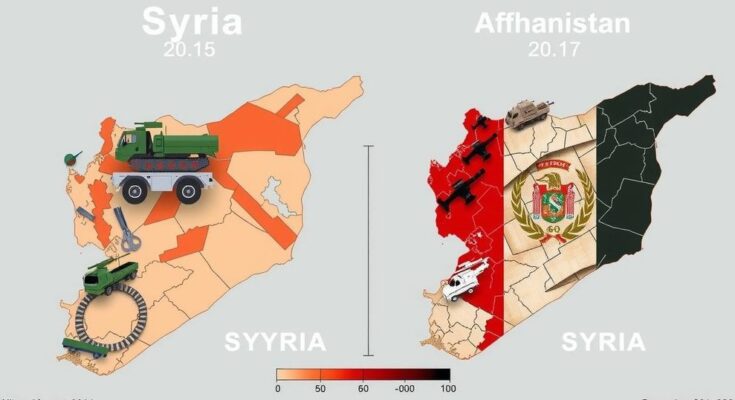The article examines the recent collapses of the Syrian and Afghan governments, analyzing the subsequent military equipment losses for both Russia and the United States. While the Taliban captured significant U.S. assets worth approximately $7 billion, the nature and potential impact of Russian equipment left in Syria are argued to have more substantial implications for military efficacy amid ongoing conflict within Ukraine. Thus, Russia’s losses could be interpreted as more damaging than those sustained by the U.S. in Afghanistan.
The recent collapse of the Syrian regime, reminiscent of the Afghan government’s fall three years prior, raises the critical question of which superpower—Russia or the United States—suffered greater losses in military equipment. Following decades of support, both nations left behind substantial arms caches in client states experiencing rapid regime changes. Syrian rebel group Hayat Tahrir al-Sham (HTS) is believed to have acquired significant weaponry from the Assad regime, potentially including tanks, artillery pieces, and aircraft; however, Israeli air strikes have complicated this situation, reportedly destroying a considerable portion of Assad’s arms stockpile. In contrast, the Taliban inherited an estimated $7 billion worth of U.S. military equipment following the collapse of the Afghan government.
Although the numbers seem heavily in favor of the Taliban, a deeper analysis reveals crucial differences. The U.S. left behind mainly outdated and less capable military assets compared to the advanced armaments that could still benefit Russia given its ongoing war in Ukraine. This differentiation, combined with emerging complexities stemming from recent Israeli military actions in Syria, indicates that the losses incurred by Russia are potentially more detrimental to its military capabilities. The stark contrast in the nature and potential impact of the weapons left to these two groups suggests a more significant blow to Russia’s military posture as it continues to struggle in Ukraine, thus painting a nuanced picture of the arms losses in both regions.
The arms relationship between Russia and Syria extends back to the Cold War, during which the Soviet Union robustly supplied military hardware to Syria. Historical data indicates that Soviet arms constituted the vast majority of Syria’s military imports, culminating in a significant arsenal that includes tanks, aircraft, and missiles. The recent surge in conflict within Syria and the subsequent fallout following government collapse resulted in a redistributing of military power. In a parallel situation, the United States’ withdrawal from Afghanistan allowed the Taliban to seize substantial U.S. military equipment, further complicating the landscape of regional power dynamics. The ongoing military conflicts, notably the war in Ukraine, have also altered Russia’s need for various arms, raising questions about its capacity to sustain military operations as it depletes its inventory of Soviet-era weapons acquired over decades.
Ultimately, the critical analysis reveals that while both Russia and the United States experienced substantial losses in military equipment due to their respective client’s collapses, the implications of these losses differ immensely. The U.S. has relinquished assets deemed less strategically significant, while Russia’s losses encompass advanced weaponry that could prove vital in its ongoing military endeavors. Consequently, the situation underscores the greater ramifications for Russia, which may encounter severe operational setbacks as it continues to engage in conflicts abroad.
Original Source: foreignpolicy.com




